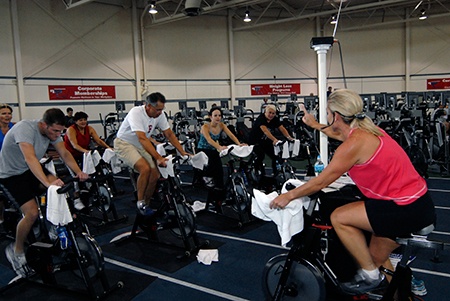 Are you one of those who either hate to run or find it is too hard on your body? You like to bike but right now it is way too cold to ride outside. Well, one of the greatest indoor group training classes that is offered is indoor cycling, or spin! While the benefits of spinning can be a whole additional blog, I’ll just say that it’s a great cardiovascular exercise as well as a tool to build strength in the legs and butt.
Are you one of those who either hate to run or find it is too hard on your body? You like to bike but right now it is way too cold to ride outside. Well, one of the greatest indoor group training classes that is offered is indoor cycling, or spin! While the benefits of spinning can be a whole additional blog, I’ll just say that it’s a great cardiovascular exercise as well as a tool to build strength in the legs and butt.
Adjusting the Bike
We’ve all been there one time or another: your toes go numb, your neck or lower back starts to hurt, or you begin to feel tingling in your fingertips. All these can be a result of not having the bike adjusted properly for your body. Don’t make the mistake of jumping onto a bike that someone else has just been riding on and think it’s the right fit.
Whether it’s a spin class, RPM, or another type of cycle class, making sure that you are set up on the bike properly is of utmost importance. Let’s take a closer, step-by-step look at how to get set up:
- Set the saddle (seat). Begin by standing next to the bike. Raise one of your knees to a 90-degree angle and locate where your hip bone is on that same leg. Once you have done so, you can put both feet back on the ground and raise or lower the seat to the spot on your hip that you have indicated. You can get onto the bike to feel for comfort. Another good indicator is that when your leg is fully extended on the pedal, there should be a 5- to 10-degree bend.
- Position your feet on the pedals. Get on the bike and place your feet so that the ball of your foot is on the axle or back part of the pedal. While pedaling, the pressure should go through the ball of your foot and not the arch. If you are wearing tennis shoes and have a cage, you will want to tighten the straps to help secure your foot.
- Position your knee. You need to be sure that your knee does not overshoot your toes. If you were to draw a straight line from the front of your kneecap down toward your foot, it should line up behind your toes. Do a few revolutions and make sure that you feel comfortable. If you are still not sure about your positioning, this is a good time for someone to easily help you. Have someone stand behind you while you are pedaling and watch your hips. There should be no movement or dropping of the hips as you extend through the pedal.
- Adjust the handlebar height. Much of this is personal preference, but there are a few tips for people who don’t bike all the time to get adjusted correctly: comfort, comfort, comfort! Start with the handlebars at the same height as the seat (look at the seat and see what your adjustment is; it may be indicated by a number or letter). As you begin to ride, you will want to be sure that you feel comfortable. Watch for neck or lower-back pain and shortness in the hamstrings. If you often ride a road bike, lower handlebars may be more comfortable. This is okay as long as you don’t begin to pull on the hamstrings.
- Adjust the distance of the handlebars. This is also heavily weighted on personal preference and comfort. You want your shoulders to be as much over your hands as possible and have a slight bend in the elbows. Remember, be comfortable! If you begin to feel tingly hands or numbness in the arms or neck, you need to adjust your handlebars.
Don’t Be Afraid to Ask for Help
If you are ever uncertain, you can always ask the class instructor to assist you. I would always advise you to get to class a few minutes early to get adjusted and ready. Enjoy, and cycle on!
This blog was written by Amanda Bireline, Fitness Center Manager. To find out more about the NIFS bloggers, click here.
